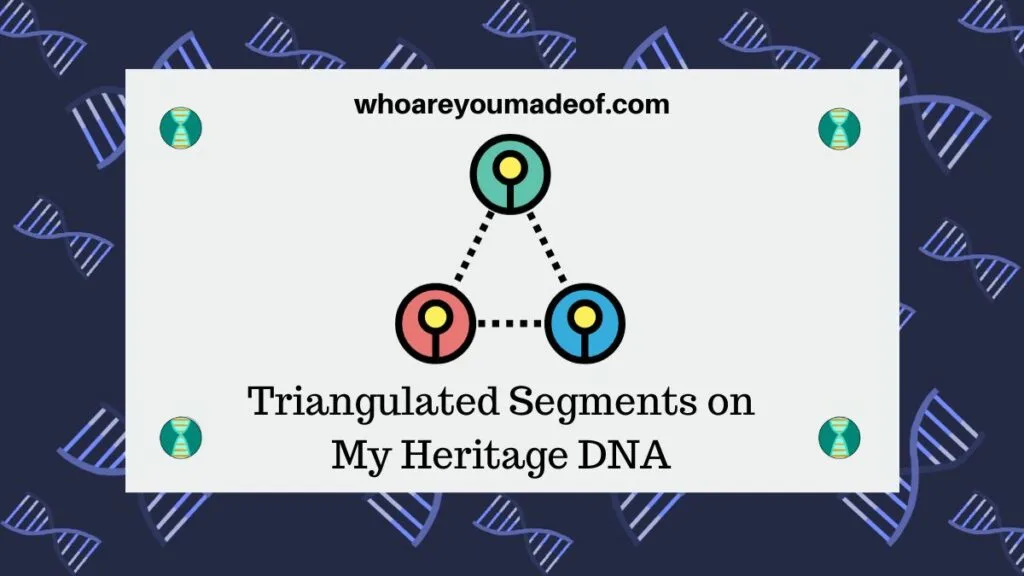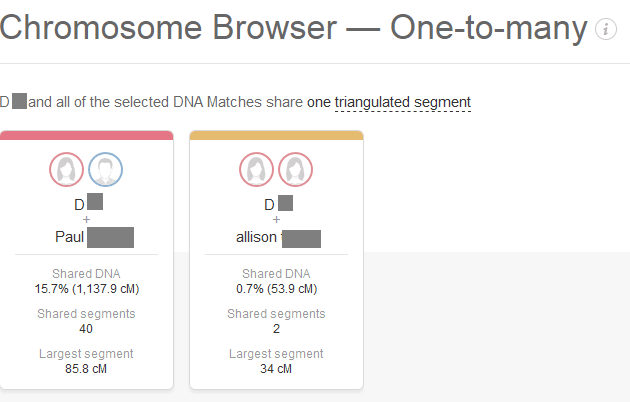Want to learn more about the triangulation feature on MyHeritage DNA? Find out how to use triangulation to learn more from your DNA matches.

My Heritage DNA has the capability to automatically triangulate segments between DNA matches. In this post, I'll explain a little bit about what triangulation is, as well as:
- how to access this feature on My Heritage
- how to use the information for your genealogy research.
It's going to save all of us so much time and effort searching through our matches.
When I first found out about this feature, I could hardly contain my excitement because this tool can be very helpful for identifying shared DNA segments between groups of matches. In turn, this can help us narrow down how we might be related to many of them.
I hope that this feature is equally exciting and helpful for you!
What is triangulation on My Heritage?
Triangulation on MyHeritage identifies identical DNA segments shared between three or more individuals. This can indicate that the group of people who share the identical DNA inherited the segment from the same common ancestor.
The word "triangulation" has two meanings in the genealogy circles. It is sometimes used to describe the process of using family trees in order to find the common ancestor among DNA matches.
It's fine to use this word in this way, but there is actually a more technical, DNA-oriented definition of triangulation. When you have a DNA match, it means that you and your match have at least one detectable segment of DNA that is at least half-identical.
Genetic genealogists can use these DNA segments, shared among multiple matches, along with (hopefully) well-researched family trees, in order to determine a common ancestor.
The idea is to try to figure out from which ancestor you inherited a particular DNA segment.
Once you've figured out which ancestor "gave" you a certain DNA segment, any time you see a new match that also matches on that segment, you can assume (sometimes) that they are also related through the same ancestor (whose identity you already determined).
The triangulation tool is just one of several very useful DNA analysis tools on the site. Another favorite is the AutoClusters Tool.
How to use the triangulation feature on My Heritage DNA
The triangulation feature is available directly on your DNA match list.
Sort your matches by largest segment
To start off, I always recommend sorting your DNA matches by "Largest Segment". While this doesn't guarantee that you are most closely related to the people at the top of the list, this is the best way to avoid DNA matches with whom you share only small segments.
Small segments could mean a very, very distant relationship - too far to reliably trace - or even no relationship, since it is possible to have DNA segments that are just coincidentally identical (identical by state).
Choose a close known relative
If you can, choose a relatively close cousin that you already know how you are related to. For these instructions, I am using my mom's DNA results, and I'll choose her first cousin on her dad's side.
It's great to choose a first or second cousin, if you can, since you will already know which line of your family that you match on. It's not foolproof, but choosing a 1st cousin eliminates 50% of the lines on your family tree because you know which grandparent you match on.
Choosing a second cousin is better because it eliminates even more of your family tree when looking for common ancestors.
If you don't know how any of your DNA matches are related to you, or you aren't sure, you can still use triangulation. In fact, it is extremely helpful.
You'll just have to use segments to search for common ancestors among your matches who do have family trees, which can help you learn more about your own family tree.
Click "Review Match"
Once you've chosen the match, click on the "Review Match" button on the cousin that you want to triangulate with:

Look for the triangulated segment icon
Once you are on the Review Match page, scroll down just a bit in order to see the DNA matches that you share in common with your chosen match. If there are available triangulated segments, you will see an icon to the right of the shared match's name and estimated relationship to your match that looks like what you see in the red rectangle in the image below.
Click on the icon!

Click the icon to access the chromosome browser
Once you clicked on the triangulated segment icon, your browser should have opened up your chromosome browser. At the top of your screen, you will see a summary of your shared DNA with your close cousin match, plus the cousin who you are trying to triangulate with:

Identify the shared segment
The final bit of information about your triangulated segment can be see when you scroll down within the chromosome browser. In this example that I am using, I can see that my mother, her first cousin, and this mysterious match share a triangulated segment of 28.9 cMs (centimorgans) on chromosome 10.
This is a great segment (the size!), and likely means a not-too-distant common ancestor between these three relatives.

My next step would be to see if my mother matches anyone else on this segment, and try to identify the common ancestor. I have another clue about my the probability of this match from the shared ethnicity that this match has with my mother.
Allison has no Eastern European, so it leads me to believe that their common ancestor is probably a great-great-great grandfather or closer, and is on my mom's grandmother's mother's side of the family. I can check through more shared matches and their trees to find out if I am right.
Tip: A spreadsheet is a great way to keep track of DNA segments and triangulated matches. You can also check out DNA Painter, a really cool website that makes triangulation easy and fun.
Conclusion
I hope that this post has helped you understand a little bit about what triangulation can do for your family tree research, and how to access and use this feature on My Heritage DNA.
I would love to hear from you in the comments if you have tried this triangulation feature, or have any questions about something that you have read here.
I try not to get too technical on this site, since I want to make sure that all of my posts are accessible and understandable for beginners, but if you want to know more about advanced topics like this, you can read about chromosome mapping and triangulation strategies.
Thanks for stopping by today!


T. Whatman
Tuesday 31st of August 2021
I am attempting to find my paternal relatives but my biological father is deceased. I have done my DNA, so has my mother and three children. Almost all of my DNA matches link to my mother and I mean thousands of them. My paternal father was Hungarian and my mother from French/Irish heritage. I am going to use an example from one of my possible Hungarian matches to show you the problem. I have one particular match Peter Raffai. When I go into his name and look at shared matches there is another gentleman S. Lamoureux. When I click on Lamoureux because the French name sets off alarm bells sure enough my mother is suddenly a shared match, although she wasn’t initially with Peter. In my mom’s DNA results Lamoureux is one of her matches but not Peter. Here are the results when I run them through the chromosome browser.
Peter and I share 2 seg 24.5cm (shared 35.5). When I add Lamoureux to see if the shared match triangulates which I assumed would since we are a match, the 3 of us don’t triangulate.
My mom, Peter and I don’t triangulate but my mom, Lamoureux and I do triangulate 2 segments. My mom shares 3 seg 15cm (32.0) with Lamoureux.
Peter, myself and two of my three children triangle 1-2 seg depending upon the combination. My third child doesn’t triangulate.
Lamoureux, myself and all three of my kids triangulate 1-2 seg again.
My 3 kids and my mom triangulate 22 seg. Add me to the mix and all of us triangulate 15 segments. Myself and 3 kids alone triangulate 43 segments.
This happens all the time when I think I have found a paternal relationship my mother’s name seems to appear. Not in the initial shared matches, but when I look into the shared matches of the initial group. Does this mean if her name appears anywhere, even if she didn’t triangulate or show up as a DNA match with Peter (in this example), that Peter is ruled out as a paternal match?
When triangulated: Myself, my mom and 3 kids = 15 triangulated seg My mom and kids = 22 triangulate seg Myself and my kids = 43 triangulate seg
I also don’t understand why on the following chart my mom appears to share more DNA with my children than I do.
My mom with kids. Me with kids Child 1 - 32 DNA seg. Child 1 - 22 DNA segments Child 2 - 29 DNA seg. Child 2 - 22 DNA segments Child 3 - 31 DNA seg. Child 3 - 22 DNA segments
I hope this makes some sense as I typed it out. Any help would be greatly appreciated as I have been trying for years to find just one DNA match I can can find the ancestral connection with, so I can prove my biological father was indeed the man my mother told me about. He was not a part of my life as he left when I was an infant.